
Engineers designing sheet-metal enclosures and assemblies often end up redesigning them so they can be manufactured. In fact, research suggests that manufacturers spend 30% to 50% of their time fixing errors and almost 24% of those errors are related to manufacturability. The reason behind these preventable engineering errors is usually the wide gap between how sheet-metal parts are designed in CAD systems and how they are actually fabricated on the shop floor. Many engineers developing 3D models for sheet-metal products are unaware of the fabrication tools used to form the part or product, and instead design models for an “ideal” world.
In the ideal world, everything is perfect. Tolerances and allowances are exact, and there’s no need to add any feature or change the design to accommodate the shop floor or real-world material behavior. But the truth is, numerous factors including chamfers at the edges, collars near hole, and spaces between drilled holes matter in the sheet metal world.
This gap between the ideal and real-world sheet-metal design usually proves costly. The overflowing engineering change orders (ECOs), fixing the design errors, and sending revisions back to the shop floor turns into a vicious cycle, one that is often difficult to break.
Closing this gap is critical. Fortunately, it’s possible if companies and engineers adopt a Design for Manufacturability (DFM) strategy. With DFM, designers can consider important manufacturability factors while developing sheet-metal designs. This reduces the possibility of errors and ECOs, and fills the void between ideal and real world. A DFM strategy focuses on simplifying designs and reducing the parts counts. It suggests standardizing parts so they can be used over and over in different applications. DFM also provides insights on developing designs that are easier to manufacture.
DFM Tips for Sheet Metal
In a sheet-metal design, specifying hole sizes, locations, and their alignment is critical. It is always better to specify hole diameters that are greater than the sheet’s thickness (T). Hole diameters less than the sheet thickness result in higher punch loading, longer burnish in the holes, and excessive burr. It also leads to slug-pulling when withdrawing the punch, which ultimately affects the life of both punch and metal sheet. Spacing between holes also matters. It should be at least two times the sheet thickness (2T), if not more. Distance between holes ensures strength of the metal and prevents holes from deforming during the bending or forming processes.
In cases where holes must be near the edge, the minimum space between the edge and holes should be at least the sheet thickness (T). Also, spaces between pierced holes and bends should accommodate the bend radius (H) and be far enough from the bend. Usually, the preferred distance between holes and a bend is 1.5 times the sheet thickness plus the bend radius (1.5T+H). Supplying 3D models without considering these factors increases the chance of change orders from the factory floor.
It is common to receive designs for sheet-metal parts with modeling mistakes regarding bends and fillets, especially when several vendors are involved. This can lead to formed parts looking different than the models they are based on.
Engineers designing sheet-metal parts should understand the importance of bend relief and how it helps avoid torn metal and that features like beads and flanges serve specific purposes. They reduce the spring-back effect and add stiffness to the final part or product. (Spring-back is the unwanted tendency of sheet metal to retain or go back to its original flat form after the forming process.) Features such as collars near pierced areas also serve a purpose. They strengthen the metal and let it withstand higher loads. Neglecting these features not only invites ECOs and extends fabrication times, it also significantly increases material scrap.
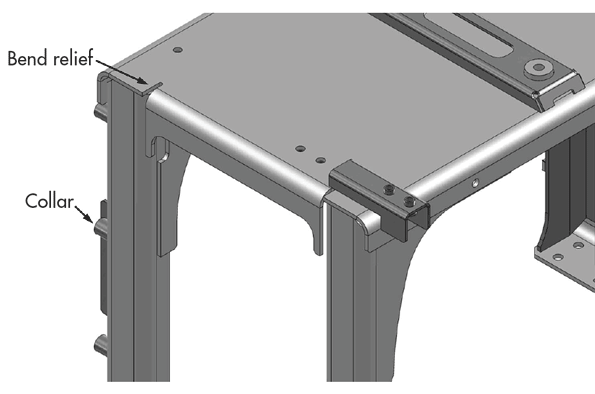
Bend relief and collars near pierced areas strengthen sheet-metal parts.
Grain structure in the metal sheet is critical for avoiding cracks in sheet-metal parts with lugs or tabs that are cut on three sides and bent in or out. Other components are often mounted or clamped to them. The engineer modeling the part needs to understand the grain structure of the metal coil that will be used. Lugs formed parallel to the grain direction usually tend to form cracks.
There might be instances in some complex product designs when this rule of thumb might not apply. Still, the recommended practice is to form lugs perpendicular or at an angle less than 45 deg. towards the grain direction. It is likely that an engineer would be unaware of this factor while developing the model. Communicating with the fabricator is key.
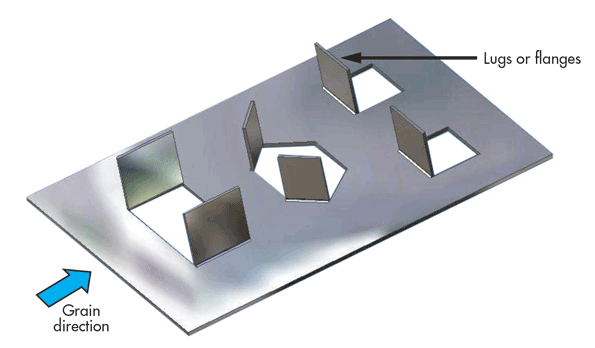
Lugs should be perpendicular or less than 45 deg. toward the grain direction.
Designers often deal in the ideal world when specifying tolerance values. However, in the real world, numerous factors affect tolerances. For example, the part’s function or feature, as well as the material type, temper, and thickness affect tolerance specifications. Moreover, engineers must consider the fabrication process that will convert the sheet metal into a part and the die accuracy and its wear during the punching operation to ensure tolerances are accurate.
From the fabricator’s point of view, the punch-to-die clearance is critical because small clearances lead to increased burr height and slug pulling, and wears out the punch prematurely. In such cases, the engineer’s tight tolerances increase manufacturing cost.
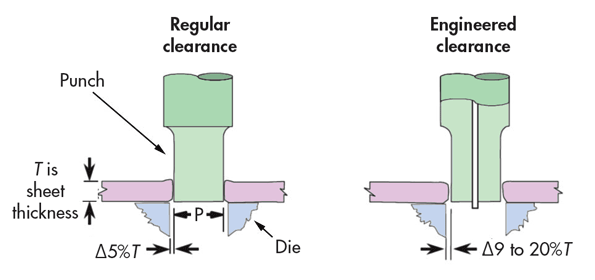
Regular clearance is an exact clearance between die and the punch and is used, but it prematurely wears out the punching too. Engineered clearance, which is slightly larger than the regular clearance is preferred because it extends the punch life. Although holes punched with engineered clearance have slightly bigger diameters, damage to the punch is greatly reduced.
Here are some other sheet-metal DFM features:
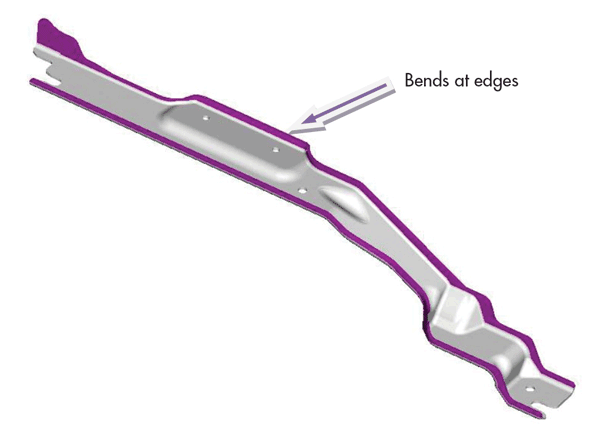
Bends at edges reduce the likelihood of metal tearing.
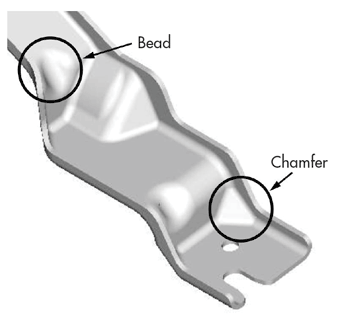
Putting chamfers at corners and beads on bends increases stiffness and reduces the spring-back effect.
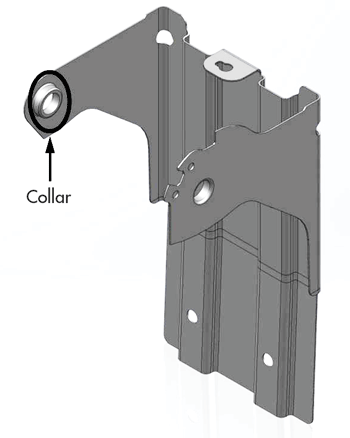
Collars increase the stiffness around pierced areas.
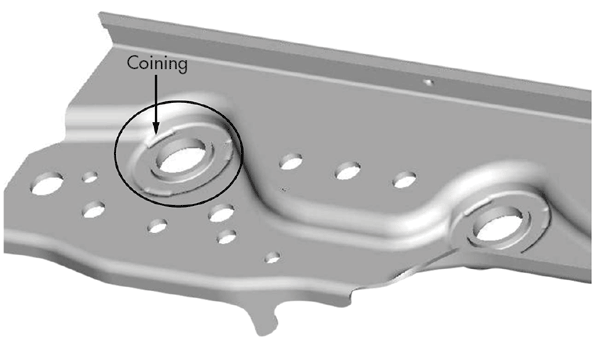
Coining and embossing around flared holes improves a part’s strength and its ability to maintain its flatness.
Benefits of DFM
Designers and engineers who adhere to the DFM guidelines strive for sheet-metal products with minimal part counts that are relatively easy to produce and assemble. The products are also less expensive and the possibilities of errors and rework are reduced.
Minimizing part count:Part counts can be shrunk by incorporating the functions of two or more parts into a single part. To do this, designers must ask themselves the following questions:
• Do the parts move relative to each other?
• Do the parts need electrical or thermal insulation?
• Do the parts need to be made of different materials?
• Does combining the parts interfere with assembly of other parts?
• Will combining parts complicate maintenance?
If the answer to all of these questions is ‘No,’ then a single part may perform several functions. This concept of theoretical minimum number of parts was first proposed by Boothroyd (1982) and is widely practiced by engineers and manufacturers across the globe. Through this approach, Dell Computer Corp. saved an estimated $15 million by redesigning a computer chassis so it could be used in several lines of PCs. And the part count went down by 50% and assembly time decreased by 32%.
Ease of assembly: This is a critical consideration for sheet-metal products. Engineers should strive to develop parts that insert into one another easily and intuitively and always with the proper orientation. Self-locking features contribute to short assembly times and lower parts counts.
Usually, it is a good practice to design the first part large and wide to ensure the stability and then assemble smaller parts on top of it. It is also a good practice to design parts in such a way that they can be assembled from one direction, rather than multiple directions, which extends assembly times further.
Ease of manufacturing: Engineers should know the manufacturing capabilities available to them and the limitations of those capabilities. This means designers should understand the processes, as well as the materials compatible with them and their production volumes. Here are some other assembly-related DFM tips:
• Use near-net shapes for molded parts to reduce machining and processing.
• Simplify fixturing by providing large mounting surfaces and parallel clamping surfaces.
• Prevent parts from breaking easily by not giving them sharp corners or points.
• Thin walls, webs, deep pockets and deep holes should be avoided so parts will withstand clamping and machining without distorting.
• Engineers should know what standard cutters, drill-bit sizes, and other tools are available in the shop before designing sheet-metal parts.
• Avoid unnecessary features as they slow production and increase machining times and cost.
It is common for large fabrication units to outsource design to engineering service providers so they can focus on core activities. However, selecting the right partner helps avoid further widening of the gap between the ideal and real worlds. Work with partners willing to collaborate, interested in knowing more about manufacturing processes, and involved in developing sheet metal products. Look for firms that have past experience of successful projects and the needed resources before handing over a design task. This will ensure that ECOs are few and the product is brought to market faster.








